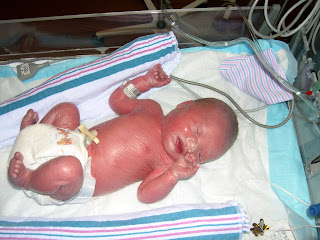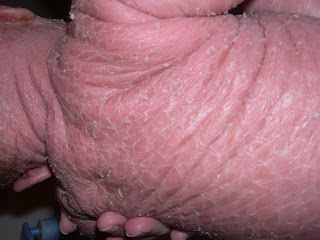 In the above photo, J was only 3 days old. G held him in his arms though the doctors feared that it could tear his skin and cause an infection that would kill him.
In the above photo, J was only 3 days old. G held him in his arms though the doctors feared that it could tear his skin and cause an infection that would kill him.  At 3 days old, you can see that J was covered in an very tight plastic like skin known as a membrane. For most, this membrane will peel and reveal new skin underneath in as little as a week. I should have known from the beginning that J was going to be stubborn like his daddy. His membrane took almost 8 weeks to completely peel. While in the NICU, J was left in only a pamper and under a humidifier. He was lotioned with aquaphor and the bassinet was sealed with Saran wrap to lock in the moisture.
At 3 days old, you can see that J was covered in an very tight plastic like skin known as a membrane. For most, this membrane will peel and reveal new skin underneath in as little as a week. I should have known from the beginning that J was going to be stubborn like his daddy. His membrane took almost 8 weeks to completely peel. While in the NICU, J was left in only a pamper and under a humidifier. He was lotioned with aquaphor and the bassinet was sealed with Saran wrap to lock in the moisture. After a week in the NICU, we were allowed to bring J home. We had to bundle him in blankets and take his temperature often. At this point, he was unable to hold his temperature. This was an exhausting process, but served us well. I had to prove to the doctors that I was able to regulate his temperature and care for his skin before we were able to be released.
At 7 weeks, you can begin to see what his skin will look like as he gets older. His form of ichthyosis doesn't allow the skin to break down and slough off. In essence, his dead skin remains on his body until it is physically peeled and removed.
At 3 months old, his skin is pretty much what it is today. Different weather and different seasons cause different reactions. I would say summer is the best time for his skin. It looks beautiful and is so much more manageable. Winter, however, is probably J's favorite season because he can actually go outside and play. Anything over 75 degrees is way too hot. Lamellar ichthyosis is one of the forms that causes the person to be unable to sweat. The inability to sweat is due to the skin not shedding properly. This is Little J's cooling vest! It weighs about 5 pounds. You insert ice packs into the pockets on the front and back of the vest. This vest has been my life saver. The vest allows J to play outside in warmer weather (best if it is under 95 degrees) for at least 30 minutes.











No comments:
Post a Comment
Thank you for visiting Natural Simplicity. I hope I have helped you on your journey to getting back to the basics.
One Pink Fish